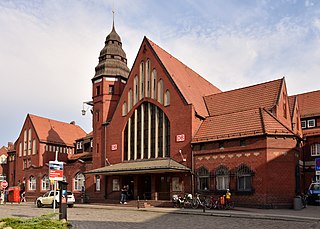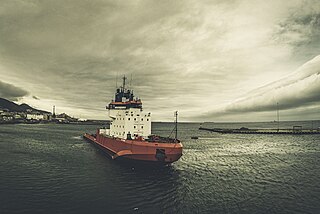
Magadan is a Russian icebreaker and the second vessel in a series of three subarctic icebreakers built at Wärtsilä Helsinki shipyard in Finland in 1982–1983. The vessel's sister ships are Mudyug and Dikson.

Ivan Susanin class, also known by its Soviet designation Project 97P, is a series of icebreaking patrol ships built for the Soviet Navy and Soviet Border Troops, and today operated by the Russian Navy and Coast Guard of the Border Service of the FSB.

CCGS Captain Molly Kool is a Canadian Coast Guard converted medium class icebreaker. She was originally built as an icebreaking anchor handling tug Vidar Viking for Trans Viking Icebreaking & Offshore in 2001. The vessel was acquired by the Canadian Coast Guard in August 2018 and was commissioned in May of the next year after refit. She is named after the Canadian sailor, Molly Kool.
A double acting ship is a type of icebreaking ship designed to travel forwards in open water and thin ice, but turn around and proceed astern (backwards) in heavy ice conditions. In this way, the ship can operate independently in severe ice conditions without icebreaker assistance but retain better open water performance than traditional icebreaking vessels.
The icebreakers of Germany include one large icebreaker, used for International polar research and dozens of smaller icebreakers that clear navigation channels of ice in Germany's territorial waters.

Arctech Helsinki Shipyard was a Finnish shipbuilding company that focused primarily on icebreakers and other icegoing vessels for arctic conditions.

Vladimir Ignatyuk is a Russian icebreaking anchor handling tug supply vessel. She was built by Burrard-Yarrows Corporation in Canada in 1983 as Kalvik as part of an Arctic drilling system developed by BeauDril, the drilling subsidiary of Gulf Canada Resources. After the offshore oil exploration in the Beaufort Sea ended in the early 1990s, she was sold to the Canadian shipping company Fednav in 1997 and renamed Arctic Kalvik. In 2003, she was purchased by Murmansk Shipping Company and transferred to Russia.

Stralsund Hauptbahnhof is the main station in Western Pomerania and the main station for railway lines running to Hamburg, Bergen auf Rügen and Berlin in the German Hanseatic city of Stralsund. It is owned and operated by Deutsche Bahn.

Louhi is a Finnish multipurpose oil and chemical spill response vessel owned by the Finnish Environment Institute (SYKE), but crewed and operated by the Finnish Navy. The ship, ordered in 2007, was built by Uki Workboat in Uusikaupunki, Finland, and entered service in May 2011.

MSV Botnica is a multipurpose offshore support vessel and icebreaker built by Finnyards in Rauma, Finland in 1998. She was the newest and technically most advanced state-owned icebreaker of Finland until 2012, when she was sold to the Port of Tallinn, Estonia for 50 million euro. Botnica is used as an escort icebreaker in the Baltic Sea during the winter months and it carries out subsea and offshore construction works worldwide during the open water season.

Murtaja was a Finnish state-owned steam-powered icebreaker. Built in 1890 by Bergsunds Mekaniska Verkstads AB in Stockholm, Sweden, she was the first state-owned icebreaker of Finland and one of the first purpose-built icebreakers in the world. Murtaja remained in service for 68 years until she was decommissioned and broken up in 1958 after having been replaced by the diesel-electric Karhu.
The Keiler is a river icebreaker commissioned in December 2011 to serve as the flagship of Lauenburg's Water and Shipping Authority fleet of ten icebreakers, on the Elbe River. The vessel is 33.21 metres (109.0 ft) long and 8.45 metres (27.7 ft) wide. She has a crew of four, and has sleeping and dining accommodation for operations that take longer than a single shift.
A Wasserstraßen- und Schifffahrtsamt is a German federal agency, responsible for the administration of federal navigable waters and for the regulation of vessel traffic.

An oblique icebreaker is a special type of icebreaker designed to operate not only ahead and astern, but also obliquely (sideways) with a large angle of attack. In this way, a relatively small icebreaker is capable of opening a wide channel in ice for large merchant ships.

Baltika is a Russian icebreaker built by Arctech Helsinki Shipyard in Helsinki, Finland. She is the first ship ever built with an asymmetric hull that allows her to operate not only ahead and astern, but also obliquely (sideways) with a large angle of attack. In this way, the relatively small oblique icebreaker is capable of opening a wide channel in ice for large merchant ships.

Polaris is a Finnish icebreaker. Built in 2016 by Arctech Helsinki Shipyard, she is the most powerful icebreaker ever to fly the Finnish flag and the first icebreaker in the world to feature dual-fuel engines capable of using both low-sulfur marine diesel oil (LSMDO) and liquefied natural gas (LNG). Polaris was initially ordered by the Finnish Transport Agency, but the ownership was transferred to the state-owned icebreaker operator Arctia after delivery.

Kigoriak was a Canadian and later Russian icebreaking anchor handling tug supply vessel. Built by Saint John Shipbuilding & Dry Dock Company for Canadian Marine Drilling (Canmar) in 1979 as Canmar Kigoriak, she was the first commercial icebreaking vessel developed to support offshore oil exploration in the Beaufort Sea.

Dobrynya Nikitich class, also known by its Soviet designation Project 97, is a diverse series of diesel–electric icebreakers and other icebreaking vessels built in the Soviet Union. In total, 32 vessels were built in various configurations for both civilian and naval service in the 1960s, 1970s and early 1980s, and several remain in service in Russia as of 2024.
CCGS Judy LaMarsh is a Canadian Coast Guard light icebreaker. Built in 2010 as a shallow-draught icebreaking tug Mangystau-2 for the Caspian Sea oil fields, the vessel was acquired by Canada as an interim solution while the existing fleet undergoes service life extension and maintenance.

Neva is a Soviet and later Russian icebreaking patrol ship in service with the Coast Guard of the Border Service of the Federal Security Service of the Russian Federation. It is one of eight Project 97P patrol ships built by Admiralty Shipyard in Leningrad in 1973–1981.
















